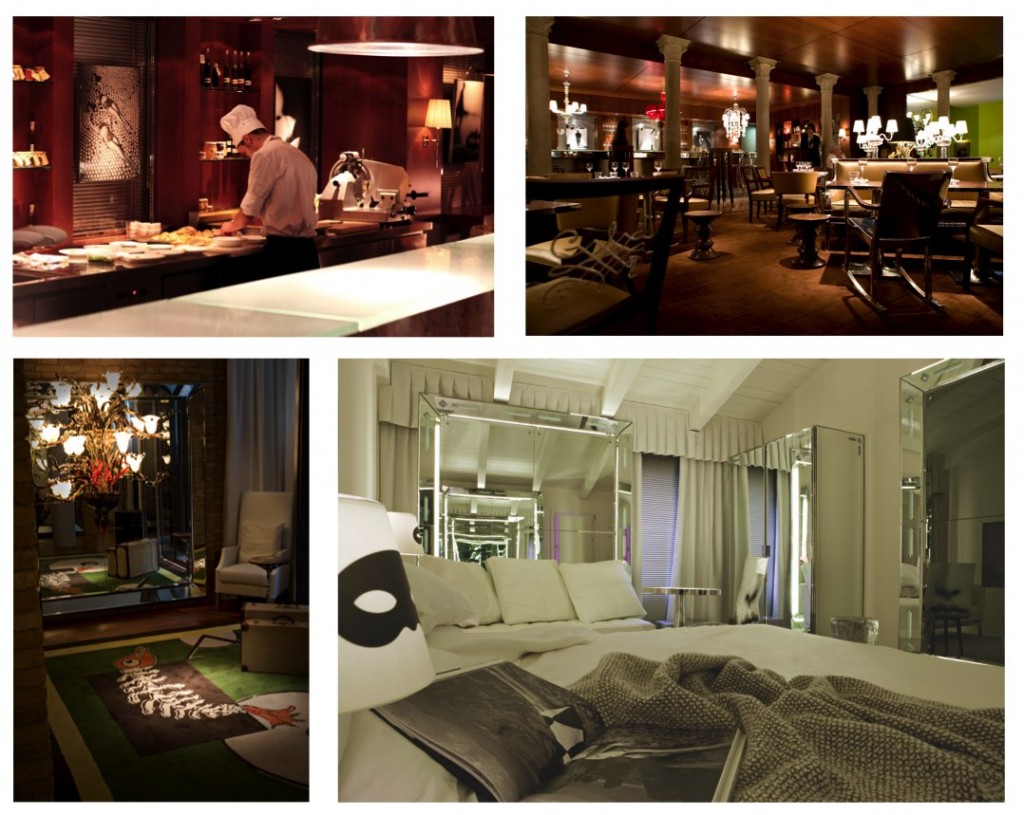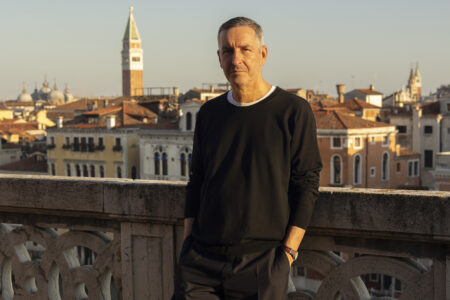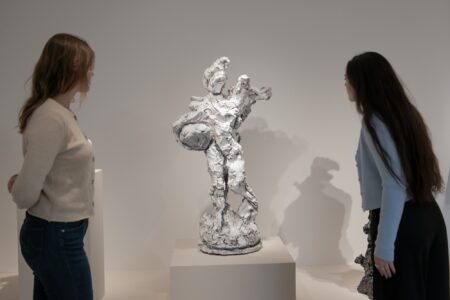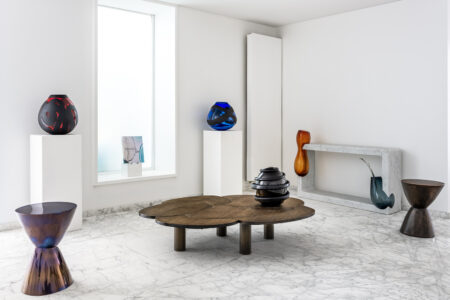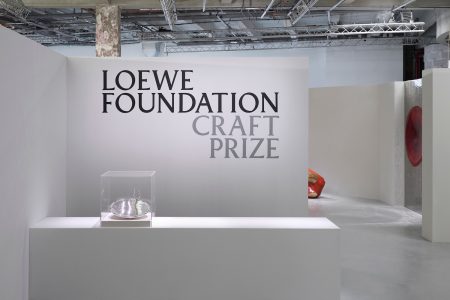Venetian Glass Masterclass/ Starck’s jewel in the lagoon
Text by Guy Dittrich/ The Palazzina Grassi is a small but beautifully formed hotel that recently opened on the Grand Canal in Venice just along from the Gallerie dell’Accademia. Multifarious French designer Philippe Starck has embellished the interiors using a mélange of glass worked by the artists and craftsmen of the lagoon city that have made glass their lives’ work.
Starck’s involvement in the interiors of this 25-room hotel has garnered many of the headlines. The usual drama associated with the maverick designer’s hotel interiors is present but the overarching element is glass. Walls are lined with huge, backlit patterned and framed mirrors reflecting an audacious series of glass artworks and individual pieces. Both the mirror and art come from Murano, the Venetian island of workshops and showrooms that reflect the city’s culture of glass. The sophistication of the art pieces, a mix of flowing sculptures frozen in time, the chandeliers, and the sheer quality of the delicately etched and engraved mirrors, create a subtle level of authenticity that leaves visitors in no doubt that they are in Venice.
Walls of slim, reclaimed Venetian brick vie for attention next to others glowing with the burnished sheen of hand-finished plaster stucco. Both are covered by the vast mirrors, hand-made in Murano by ARTIGIANATO ARTISTICO VENEZIANO (AAV). The angled edges of the mirrors, neatly beveled with fine scalloped-detailing are framed with slim strips of chrome. Selected by Starck from the family business of brothers Vincenzo and Giovanni Barbini that supplied the original mirrors for the Palace of Versailles in the 17th Century, there is a reassuring timelessness to their design.
Collaborations renewed
The Barbini’s have collaborated with Starck before, at the Sanderson Hotel in London, but the scale of their involvement in their hometown was tremendous given the size of the hotel. Over 289 mirrors were delivered for the Palazzina Grassi project. “Each one is hand made,” explain the brothers, “We start by cutting the mirror to size followed by the engraving and any decorative items such as flowers and leaves.” The mirrors are huge but rather than creating them on site, were completed in Murano before being shipped the short distance to the hotel.
An additional unique feature of the mirrors is that they are backlit by strips of led lights. Using a new technique developed in conjunction with the Politecnico di Torino and the industrial company Delta Impianti, the led lighting is dimmable via a series of ‘smart’ control boxes. The result is that the reflected light can be self-regulated to allow the guestroom spaces in particular to assume a variety of roles both within circadian rhythms and from one guest to another.
The vast expanses of mirror and chrome present two different challenges. Firstly, any doubts over the coldness of all those reflective surfaces is banished by the variability of the led lights and the plush furnishings of the bed, the Fornasetti-patterned chairs, the underlit Moonstone and onyx table tops, the masks stenciled on lampshades and a myriad of other small but tangible decorative touches. So confident is Starck of the overall comfort levels that even cupboards are covered in reflective chrome and, in the master suite, the cupboard is actually made of glass. Guests need to pack their most beautiful wardrobe! Secondly, the scale of mirrored surfaces could be seen as an operational nightmare. Clearly this is not the guest’s problem but the reality is that just as they don’t tend to touch walls they also don’t touch the mirrors. Tempting as it may be.
Glass from another world
The mirrors from AAV also provide the backdrop for a number of the appliqué masterpieces commissioned by Starck from artist Aristide Najean. Born in Algeria, Najean has lived on Murano since 1986 mastering the craft of working with glass. “It is an intense process,” he describes, “the glass dominates you at 1,200°C. You have to work quickly. You have to follow the rhythm of the glass.”
The overwhelming theme behind these decorative glass elements is that of a journey. “Palazzina Grassi is the middle point of civilisation,” explains Najean, “between the water and the earth. Between the lagoon and land.” Take the swirling tentacles of the Gorgan-like appliqués that sit opposite each other in the hotel. The infinity of their reflections in the framed Barbini brother’s mirrors has Najean seeing them as never-ending nets in which there is a physical fascination for the guests. A little red crab peers quizzically up through the tentacles. Trapped or enraptured? The decision is in the eye of the beholder.
At the narrow entrance to the main colonnaded restaurant / bar of the hotel is a small alcove with another of Najean’s whimsical sculptures. In the surrounding bronze mirrored tiles are strange parts of limbs – half-in, half-out. Perhaps an elbow or is that a knee? “They are an invitation to begin the journey. Either you see them (at face value) or you are taken by the arm and make the step behind the story,” suggests Najean of the mystical element he has introduced.
Complicity between artists
“We understand each other as we understand the artistic references,” he explains of his relationship with Starck whom he describes as “intelligent, sensitive and charming”. “It (the brief) is more of a suggestion than a precise idea,” continues Najean who has also worked with Starck on pieces for Le Royal Monceau hotel that recently opened in Paris. His latest work sees the development of glass into the forms of flowing water such as the Catarata, a 4-metre high cascading glass chandelier for Buenos Aires decorator Laura O Tep.
Najean’s contribution at Palazzina Grassi extends beyond the appliqués to the hotel’s signage at both the Grand Canal entrance and the calle, alleyway entrance. That is if two glass bull heads can be taken as signage. Certainly the hotel’s devotion to discretion is acute to the extent of almost being on a “need to know” basis. A point doubtless appreciated by its A-list guests that included Johnny Depp who was a guest whilst filming The Tourist, with Angelina Jolie. Najean doesn’t worry himself about such details focusing rather on the imagery behind the bulls that have a far more friendly and welcoming look than the more monstrous Gargon-like appliqués inside. “The bulls represent the fight between man and the bull. Of light and darkness. A middle point. The strength of the animal that yet can be dominated by man,” he explains.
Anti-conformism reflects magical setting
A further bull-fighting reference is seen in the stone-columned restaurant and bar. This area together with the adjacent Krug Lounge, overlooking the Grand Canal, is the heart of the hotel. Here Starck has chosen to display numerous of Najean’s diverse range of glass pieces amongst the deep leather sofas and on the library-like shelving. Amongst them is Nimeno II, a small but striking piece depicting the delicate moment when a matador just avoids the raging bull. The gold speckled glass reflects the matador’s traje de luces, “suit of lights”, as their outlandish uniforms are known; the bull is complete with barbed banderillas, trailing from its neck. The imagery may not be everyone’s cup of tea but the delicacy of the execution is stunning. Other less provocative pieces such as the Météorite, of silver and aventurine, and the Serpent d’Or vase, are amongst dozens on display.
In spite of the mohair throws, fragile looking wooden rocking chairs and Najean’s artwork, the interiors of the restaurant / bar have a distinctly clubby, masculine feel. The mahogany wood, used in tribute to the gondoliers, and the dim lighting from the Murano chandeliers over the bar create a moody scene ideal for cozying up on a foggy winter’s day in Venice. The restaurant comprises a float glass topped counter fronting the show kitchen. Manning the galley stoves is chef Luigi whose previous experience includes spells at Locanda Locatelli and Zuma in London. All of this is balanced by the femininity of the guestrooms above. Corridors with vast sweeps of white curtains and chrome-framed black and white portraits lead to the sanctuary of the mirror-lined bedrooms.
The Starck effect
The Palazzina Grassi is Starck’s first hotel in Italy following a long apprenticeship with Ian Schrager and the Morgans Hotel Group. Their relationship delivered a hatful of iconic properties including the Royalton in Manhattan, before its recent make over, the Delano in Miami, the St Martins Lane and the Sanderson, both in London. Starck came in for significant criticism at many of these hotels for their lack of livability with outsized, uncomfortable furniture that upped the gaudy, gimmick factor. Hotels that captured the Zeitgeist of metropolitan life but largely managed to enhance the guest experience precisely once.
Amidst the expected Starck’isms – acres of gauzy drapes, playfully humorous interior design and impractical basins – Palazzina Grassi heralds a new approach. Guests will find a stunningly luxurious and comfortable series of living spaces with outstanding levels of anticipatory service. Just the sort of space that engenders repeat business, the holy grail of hoteliers. Make no mistake, Starck’s approach to the interior design is still full of surprises in no small way due to the glass interventions. “Palazzina Grassi can change you. It is the sort of place you go into and don’t know how you will come out,” dramatises Najean.
Working with Starck
Indeed, owner Emanuel Garosci describes the hotel as “an emotional tornado”. Garosci, no stranger to working with high profile designers (Matteo Thun did the interiors at his Nhow Hotel in the heart of Zona Tortona, well known to attendees of the Milano Salone each Spring, and he collaborated with Karim Rashid at the Nhow Berlin) is to be congratulated in managing to distill the essence of Starck at Palazzina Grassi. “It was a great challenge,” he explains, “but I wanted to work with him so I put up with the arguments.” Garosci sees Starck as the number one hotel designer and not just from a professionals’ point of view but also from that of the end user. “Starck excites you, whereas (the style of) Andre Putman relaxes people,” he compares.
Garosci is a native of Turin but, like Starck, he has made Venice his home and, typical of “outsiders” looking in at a place, it is their interpretation of Venice at Palazzina Grassi that stands out. Moving well past the antiquated velvets and damasks of many of the other quality hotels in Venice, there is so much difference at the hotel it is proving a strong draw for Venetians keen on something new.
Continue reading on glass and lighting in TL9!
(Text by Guy Dittrich / Images: Aldo and Cristiana Martinelli)
